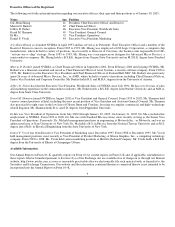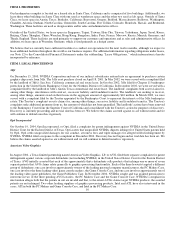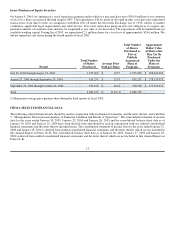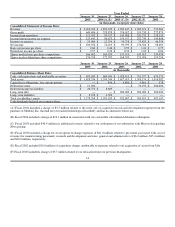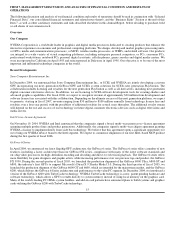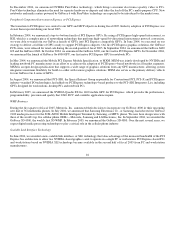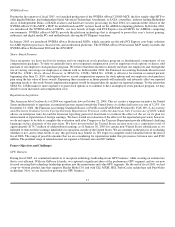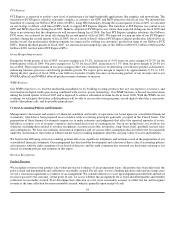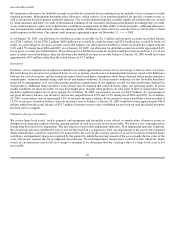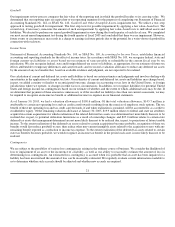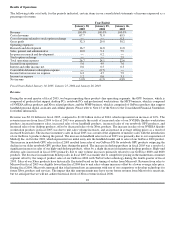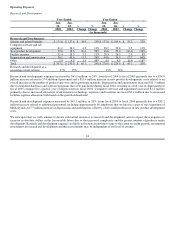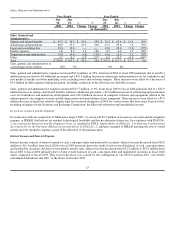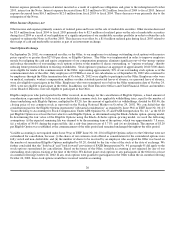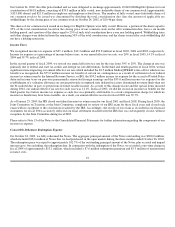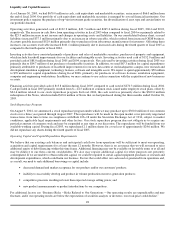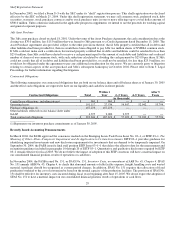NVIDIA 2005 Annual Report Download - page 25
Download and view the complete annual report
Please find page 25 of the 2005 NVIDIA annual report below. You can navigate through the pages in the report by either clicking on the pages listed below, or by using the keyword search tool below to find specific information within the annual report.
Our policy on sales to distributors is to defer recognition of revenue and related cost of revenue until the distributors resell the product.
We record estimated reductions to revenue for customer programs at the time revenue is recognized. Our customer programs primarily
involve rebates, which are designed to serve as sales incentives to resellers of our products in various target markets. We account for
rebates in accordance with Emerging Issues Task Force Issue 01−9, or EITF 01−9, Accounting for Consideration Given by a Vendor
to a Customer (Including a Reseller of the Vendor's Products) and, as such, we accrue for 100% of the potential rebates and do not
apply a breakage factor. Unclaimed rebates, which historically have not been significant, are reversed to revenue upon expiration of
the rebate. Rebates typically expire six months from the date of the original sale.
Our customer programs also include marketing development funds, or MDFs. We account for MDFs as either a reduction of revenue
or an operating expense in accordance with EITF 01−9. MDFs represent monies paid to retailers, system builders, OEMs, distributors
and add−in card partners that are earmarked for market segment development and expansion and typically are designed to support our
partners' activities while also promoting NVIDIA products. If market conditions decline, we may take actions to increase amounts
offered under customer programs, possibly resulting in an incremental reduction of revenue at the time such programs are offered.
We also record a reduction to revenue by establishing a sales return allowance for estimated product returns at the time revenue is
recognized, based primarily on historical return rates. However, if product returns for a particular fiscal period exceed historical return
rates we may determine that additional sales return allowances are required to properly reflect our estimated exposure for product
returns.
License and Development Revenue
For license arrangements that require significant customization of our intellectual property components, we generally recognize
license revenue using the percentage−of−completion method of accounting over the period that services are performed. For all license
and service arrangements accounted for under the percentage−of−completion method, we determine progress to completion based on
actual direct labor hours incurred to date as a percentage of the estimated total direct labor hours required to complete the project. We
periodically evaluate the actual status of each project to ensure that the estimates to complete each contract remain accurate. A
provision for estimated losses on contracts is made in the period in which the loss becomes probable and can be reasonably estimated.
To date, we have not recorded any such losses. Costs incurred in advance of revenue recognized are recorded as deferred costs on
uncompleted contracts. If the amount of revenue recognized exceeds the amounts billed to customers, the excess amount is recorded
as unbilled accounts receivable. If the amount billed exceeds the amount of revenue recognized, the excess amount is recorded as
deferred revenue. Revenue recognized in any period is dependent on our progress toward completion of projects in progress.
Significant management judgment and discretion are used to estimate total direct labor hours. Any changes in or deviations from these
estimates could have a material effect on the amount of revenue we recognize in any period.
Investment Impairments
We review all of our investments quarterly for indicators of impairment. For non−marketable equity securities, the impairment
analysis requires significant judgment to identify events or circumstances that would likely have a significant adverse effect on the fair
value of the investment. The indicators that we use to identify those events or circumstances include the investee's revenue and
earnings trends relative to predefined milestones and overall business prospects, factors related to the investee's ability remain in
business, such as the investee's liquidity, and the investee's receipt of additional funding at a lower valuation.
Investments identified as having an indicator of impairment are subject to further analysis to determine if the investment is other than
temporarily impaired, in which case we write the investment down to its impaired value. When an investee is not considered viable
from a financial point of view, we write down the entire investment since we consider the estimated fair market value to be nominal. If
an investee obtains additional funding at a valuation lower than our carrying amount or requires a new round of equity funding to stay
in operation and the new funding does not appear imminent, we presume that the investment is other than temporarily impaired, unless
specific facts and circumstances indicate otherwise. Impairments of investments in our portfolio, primarily impairments of
non−marketable equity securities, were nil in fiscal 2005 and 2004.
19


